[Crypto Trading Strategy with Triple Exponential Moving Average (TEMA) indicator] - Crypto Academy / S6W2 - Homework Post for professor @fredquantum.

Question 1
What is your understanding of Triple Exponential Moving Average (TEMA)?
Triple Exponential Moving Average
The triple exponential moving average is a variant of the exponential moving average indicator that is comprised of a single oscillating line that is calculated from combining 3 exponential moving averages using the same period. The TEMA Indicator was developed by Patrick Mulloy in his attempt to reduce the lagging associated with the other types of moving average indicators. The TEMA indicator was widely used in stock market trading before its slow transition and adoption within the crypto ecosystem.
The TEMA works by applying a smoothing function generated from its calculation. This function ensures that lags and random price fluctuation are ignored by the indicator, resulting in a smoothened representation of the indicator data in relation to price movement. This makes the TEMA an ultimate choice in identifying trends, trend structure, support, and resistance areas using the average indicator.
The TEMA indicator follows price movement closely and is calculated from the most recent price data changes, and its fast reaction to price movement and indication of a trend change is why most traders prefer it to the other forms of moving averages.
Similar to other moving averages, the TEMA indicator represents trends directions using the angled slope of its oscillating line. Ideally, a bullish trend can be easily identified with the upward angle slope of the indicator line with price movement stating above the TEMA indicator line. While a bearish trend can be identified with the downward angle slope of the indicator line with price movement staying below the TEMA indicator line.

Question 2
How is TEMA calculated? Add TEMA to the crypto chart and explain its settings. (Screenshots required).
TEMA Calculation
The triple exponential moving average (TEMA) has a mathematical expression that represents its calculation. The expressions are as follows:
TEMA = (3 × EMA1) - (3 × EMA2) + EMA3
Where;
EMA1 = Exponential moving average
EMA2 = EMA of EMA1
EMA3 = EMA of EMA2
Following this expression, the calculation is comprised of 3 EMAs, each using the same period, this ensures uniformity in EMA data obtained. The TEMA also applies a repeating coefficient of 3 in its EMA 1 and 2, this ensures that the product values of the TEMA indicator are smoothened across the specified period.
Adding TEMA to Price Chart
To add the TEMA indicator to a price chart, access any price chart platform that supports the use of the indicator and access the price chart. For this illustration, I chose the tradingview platform.
First, visit Tradingview's website and access the price chart.
On the price chart, click on the indicator icon to add the indicator of choice. Then search for the indicator using any relevant keyword like TEMA, Triple EMA, etc.
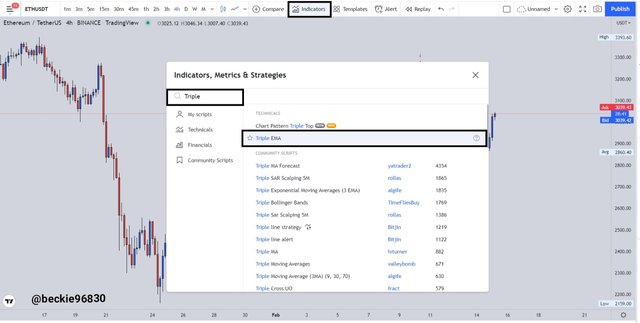
Next click on the indicator to add it to the price chart.
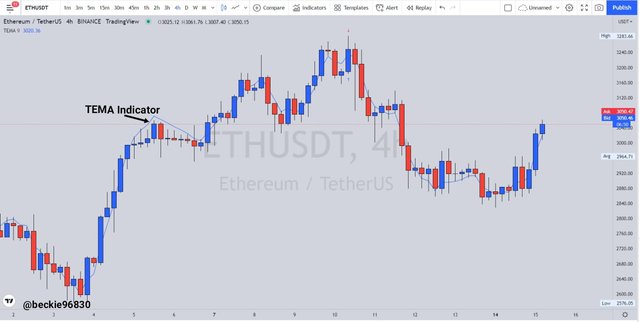
Hover on the indicator name and click on the settings icon to configure the indicator to the desired configuration.
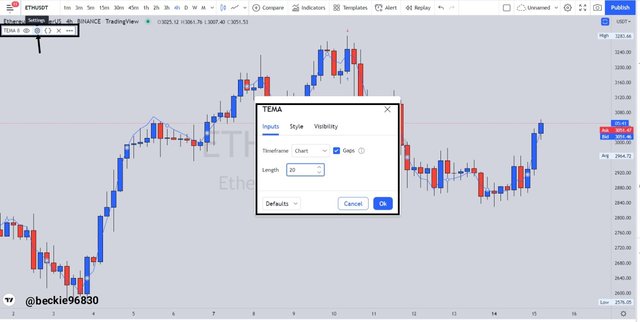
The indicator has a default period setting of 9, which is ideal for short-term trading systems like scalping. Though shorter indicator period setting in some cases generates distorted signals. But with a higher period setting like 20, 21, 25, etc the indicator generates a better indication of possible price movements when compared to the short-term period of 9. I chose a period setting of 20 for this indicator, which is more reliable for clearer indications.

Question 3
Compare TEMA with other Moving Averages. You can use one or two Moving Averages for in-depth comparison with TEMA.
1- Comparing The TEMA and The EMA
As previously explained, the TEMA indicator was developed to reduce the lag associated with other types of moving averages, making it a more efficient and reliable trend indicator. The TEMA indicator follows price movement very closely and hints at trends, trend reversal, support, and resistance levels faster than other types of moving averages.
To fully understand the difference, I will compare the representation of the TEMA and an EMA indicator on a price chart. Consider the chart below:
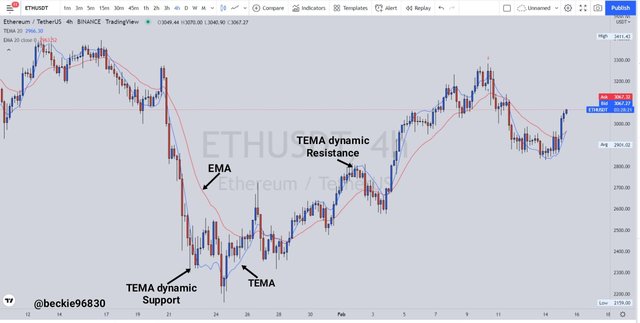
Observing the chart above, the two moving averages (TEMA and EMA) are set for the same period of 20. The TEMA (blue line) follows price movement very closely, indicating changes in price movements, trend reversals, support and resistance levels, etc faster than the EMA. The lag between the TEMA and the EMA (Redline) can be expressed as the gap between the two moving averages in relation to price movement.
Following price development, the TEMA indicator serves as dynamic resistance to price in an uptrend, because of its fast and up close movement to price. While also serving as dynamic support to price in a downtrend, also because of its fast and close proximity to price movement.
Comparing the TEMA and EMA shows the visible lag of the EMA, as a better, enhanced, and efficient indicator reading can be obtained from the TEMA indicator. This is credited to the TEMA calculation comprising of 3 EMA indicators.
Comparing The SMA, EMA, And The TEMA
The SMA is another type of moving average that is calculated from the average price within a given interval. This makes the SMA lag more than the EMA and the TEMA because all price data are treated equally, unlike the EMA that focuses on recent price changes.
To fully understand the difference, I will compare the representation of the TEMA, EMA, and the SMA indicator on a price chart using a period of 20 for all the indicators. Consider the chart below:
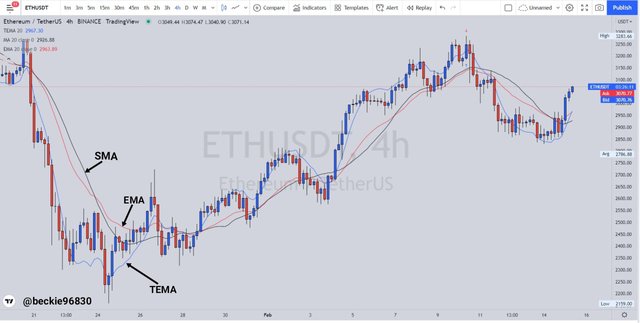
Observing the chart above, the three moving averages (TEMA, EMA, and SMA) are set for the same period of 20. The TEMA (blue line) follows price movement very closely, indicating changes in price movements, trend reversals, support and resistance levels, etc faster than the EMA (Redline) and the SMA (Blackline).
The lag between the TEMA and the other two moving averages can be expressed as the gap between the three moving averages in relation to price movement, where the EMA is closer than the SMA, this implies that the EMA has a lesser lag when compared to the SMA.
Following price development, the TEMA indicator serves as dynamic resistance to price in an uptrend, because of its fast and up close movement to price. But the SMA and EMA serve as dynamic support in an uptrend, as price tap and reject the EMA and SMA during pullbacks to continue its trending movement.
While the TEMA serves as dynamic support to price in a downtrend, also because of its fast and close proximity to price movement. But the EMA and SMA serve as dynamic resistance in a downtrend, as price tap and respects the EMA and SMA during pullbacks to continue its trending movement.
In general, the TEMA is more efficient and complete moving average when compared to the other types of moving average because of its relative quickness to price changes.

Question 4
Explain the Trend Identification/Confirmation in both bearish and bullish trends with TEMA (Use separate charts). Explain Support & Resistance with TEMA (On separate charts). (Screenshots required).
Trend Identification Using TEMA
The TEMA indicator like other types of moving averages is a trend-based indicator that reduces the lags associated with price data representation of the moving averages. The TEMA indicator identifies the trend with the direction of the indicator line, usually moving in the same direction as the identified trend. The angle of the indicator line reveals the current trend and also hints at possible price changes, thus providing traders with trade opportunities.
TEMA Indicator Identifying a Bullish Trend
The TEMA indicator identifies the bullish trend with the angle of its line moving upwards in the same direction as price movement. To confirm the trend, the price movement should be above the TEMA indicator in a bullish trend. To illustrate this, consider the chart below:
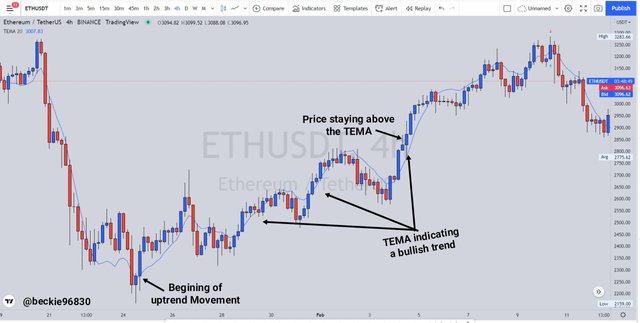
Observing the chart, the TEMA indicator identified the current trend with its movement correlating with price movement upwards. The trend was confirmed with price movement trading above the TEMA indicator line.
TEMA Indicator Identifying a Bearish Trend
The TEMA Indicator identifies the bearish trend with the angle of its line moving downwards in the same direction as price movement. To confirm the trend, the price movement should be below the TEMA indicator in a bearish trend. To illustrate this, consider the chart below:
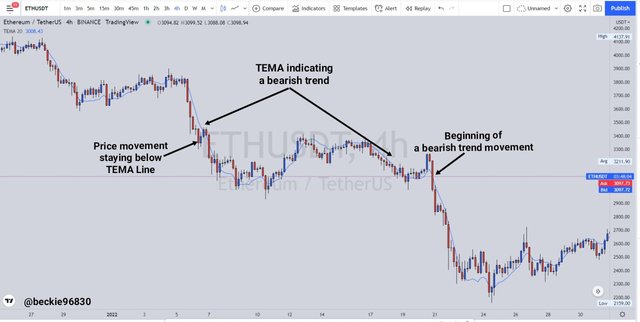
Observing the chart, the TEMA indicator identified the current trend with its movement correlating with price movement downwards. The trend was confirmed with price movement trading below the TEMA indicator line.
TEMA and Resistance
The TEMA indicator serves as dynamic resistance to price movement in an uptrend, unlike other types of moving averages that serve as dynamic support to price movement in an uptrend. When price approaches the dynamic resistance (TEMA line) it rejects the resistance, which is an indication for a possible trend reversal i.e from. bullish to bearish. The TEMA also hints at a possible trading opportunity, such that after pullbacks the buy trade can be executed once the TEMA indicator line is rejected by price. To illustrate this, consider the chart below:
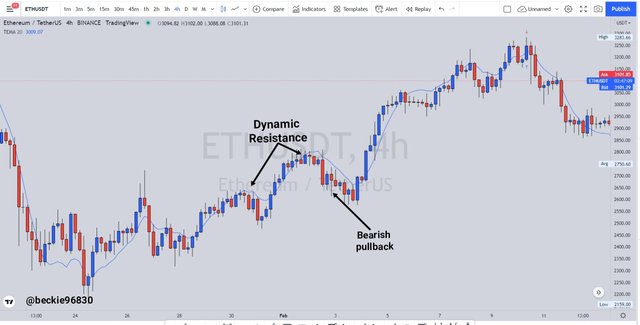
Observing the chart, the TEMA line can be seen serving as dynamic resistance to price movement. When the dynamic resistance is respected, the price tends to reject and pull back before a continuation of the bullish trend is encountered. These resistance areas can be used in identifying bullish trade exit points, and the end of the bearish pullback can provide bullish trade opportunities.
The TEMA also offers a chance to catch the pullbacks (bearish pullback) in a bullish trend, after the TEMA line has been rejected (dynamic resistance) a short-term sell trade can be executed with proper risk management.
TEMA and Support
The TEMA indicator serves as dynamic support to price movement in a downtrend, unlike other types of moving averages that serve as dynamic resistance to price movement in a downtrend. When the price approaches the dynamic support (TEMA line) it rejects the support, which is an indication for a possible trend reversal i.e from bearish to bullish. The TEMA also hints at a possible trading opportunity, such that after pullbacks the sell trade can be executed once the TEMA indicator line is rejected by price. To illustrate this, consider the chart below:
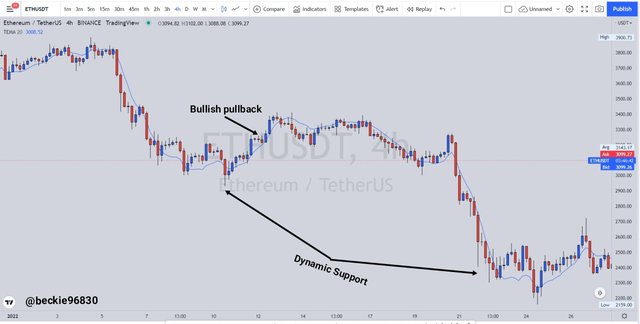
Looking at the chart, the TEMA line can be seen serving as dynamic support to price movement. When the dynamic support is respected, the price tends to reject and pull back before a continuation of the bearish trend is encountered. These support areas can be used in identifying bearish trade exit points, and the end of the bullish pullback can provide bearish trade opportunities.
The TEMA also offers a chance to catch the pullbacks (bullish pullback) trades in a bearish trend, after the TEMA line has been rejected (dynamic as support) a short-term buy trade can be executed with proper risk management.

Question 5
Explain the combination of two TEMAs at different periods and several signals that can be extracted from it. Note: Use another period combination other than the one used in the lecture, explain your choice of the period. (Screenshots required).
Combining Two TEMA Indicators
Combining Two TEMA is a trading strategy that utilizes two TEMA indicators with different period settings, with one having a shorter setting and the other a longer period setting. Ideally, the TEMA indicator with a shorter period setting reacts faster to price movement while the TEMA indicator with a longer period setting reacts slower to price movement.
The combination of the two TEMA indicators is used by traders to identify buying and selling opportunities in a traded market. For this illustration, I chose the 20 and 50 period TEMA because of how smooth they represent price change in the short to medium term.
Ideally, when a TEMA with a smaller period (20) setting crosses above the TEMA with a higher period (50) setting it is considered a bullish signal, hinting at buyers being in control of price movement. A buy trade can be executed after the crossover and price bouncing off the TEMA as support. To illustrate this, consider the chart below:
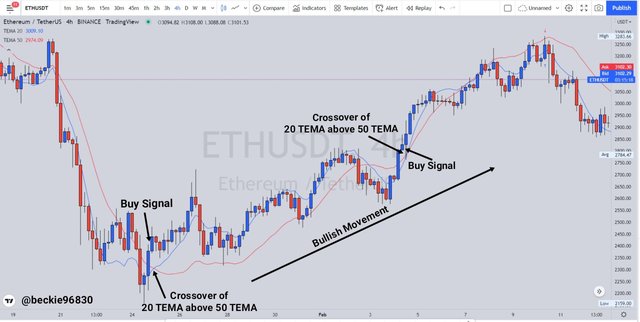
Observing the chart, the 20 TEMA crossed above the 50 TEMA which indicated the presence of buyers being in control of price. Following the subsequent development of price, the uptrend was maintained with the formation of consistent higher highs and higher lows.
Similarly, when the TEMA with a higher period (50) setting crosses above TEMA with a smaller period (20) setting, it's considered a sell signal, hinting at sellers being in control of price movement. A sell trade can be executed after the crossover and price bouncing off the TEMA as resistance. Consider the chart below:
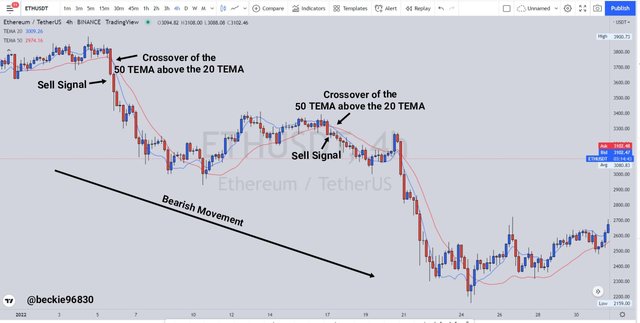
Looking at the chart, the 50 TEMA crossed above the 20 TEMA which indicated the presence of sellers being in control of price. Following the subsequent development of price, the downtrend was maintained with the formation of consistent lower highs and lower lows.

Question 6
What are the Trade Entry and Exit criteria using TEMA? Explain with Charts. (Screenshots required).
Trade Entry and Exit Criteria using TEMA
Trading with the TEMA requires certain conditions are to be satisfied before a trade can be executed or exited. For this demonstration, I chose the TEMA crossover strategy and some of the conditions include:
Buy Trade Entry and Exit Criteria
For a buy trade, the following conditions must be satisfied:
Add the two TEMA to the price chart with different period settings.
Following a downtrend move, wait for a crossover of the smaller period TEMA above the higher period TEMA. This indicates the presence of buyers being in control of price.
After the crossover, wait for the price to break above the TEMA and use at least two candlesticks (bullish candlestick) confirmations.
The buy trade can be exited when the price approach a resistance level along the TEMA line. Take profit and stop loss should be added in ratios of 1:2 to ensure a positive trade balance is maintained.
Consider the chart illustration below:
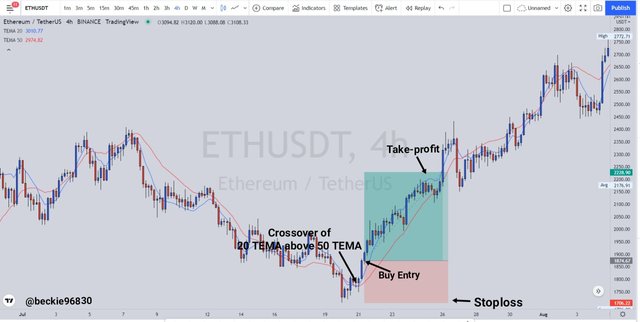
Observing the chart, following the bearish move, a crossover of the smaller TEMA period above the higher period TEMA was encountered. Followed by price movement breaking above the TEMA lines, this confirmed the presence of buyers being in control of price. A buy trade can be executed after two bullish candles confirmation with stoploss placed below the previous low and take profit targeting the nearest resistance.
Sell Trade Entry and Exit Criteria
For a Sell trade, the following conditions must be satisfied:
Add the two TEMA to the price chart with different period settings.
Following an uptrend move, wait for a crossover of the higher period TEMA above the smaller period TEMA. This indicates the presence of sellers being in control of price.
After the crossover, wait for the price to break below the TEMA and use at least two candlesticks (bearish candlestick) confirmations.
The sell trade can be exited when the price approach a support level along the TEMA line. Take profit and stop loss should be added in ratios of 1:2 to ensure a positive trade balance is maintained.
Consider the chart illustration below:
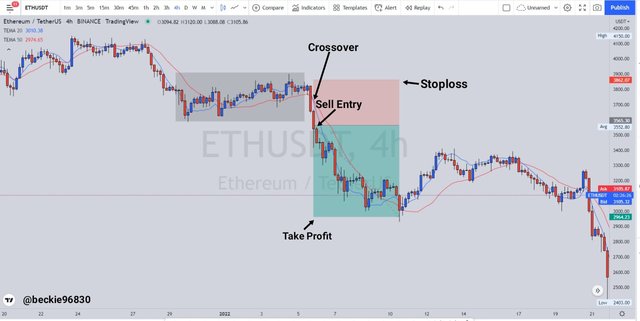
Observing the chart, following the bullish move, a crossover of the higher TEMA period above the smaller period TEMA was encountered, followed by price movement breaking below the TEMA lines, this confirmed the presence of sellers being in control of price. A sell trade can be executed after two bearish candles confirmation with stoploss placed above the previous high and take profit targeting the nearest support.

Question 7
Use an indicator of choice in addition with crossovers between two TEMAs to place at least one demo trade and a real margin trade on an exchange (as little as $1 would do). Ideally, buy and sell positions (Apply proper trade management). Use only 5 - 15 mins time frame. (Screenshots required).
RSI and TEMA Indicator
The RSI is an indicator that indicates the condition of a given market in terms of overbought, oversold, or balanced market. This is done with the RSI levels of 30 and 70. Ideally, when the price moves below the 30 RSI level, it's considered that the market is in an oversold state and a possible bullish reversal signal. While a move above the 70 RSI level indicates that the market is in an overbought state and a possible bearish reversal signal.
To combine the RSI and TEMA, the two indicators must satisfy the conditions for a crossover and corresponding market conditions state.
1- Demo Trade (SELL Trade) XRPUSDT 15 MINS
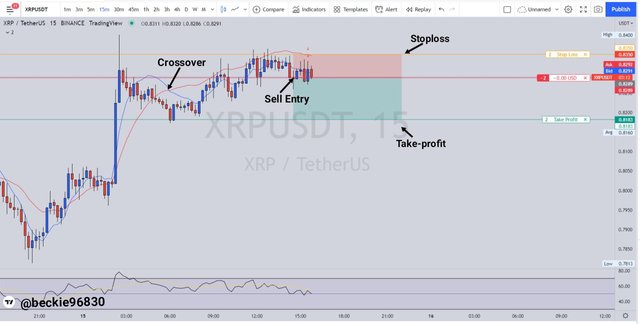
Observing the chart above, a crossover of the 50 TEMA above the 20 TEMA, which indicated the presence of sellers being in control of price. the RSI correlated with the sentiment, with its movement breaking below the 50 midpoint, which confirms the selling momentum is increasing. I executed a sell trade order in my paper trading account at $0.8289, with stoploss placed at $0.8350 and take Profit placed at $0.8183. The risk to reward on the trade was in a ratio of 1:1.7.
The sell trade execution
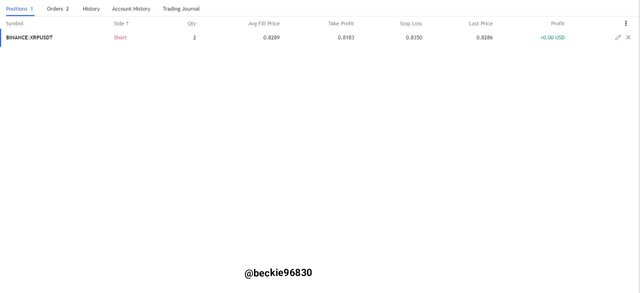
2- Real Trade (Buy Trade) DOGEUSDT 5 MINS
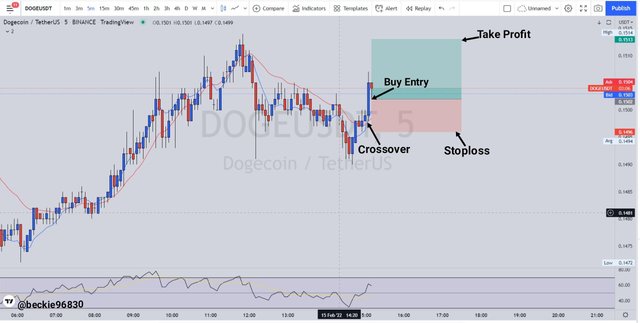
Observing the chart above, a crossover of the 20 TEMA above the 50 TEMA, which indicated the presence of buyers being in control of price. the RSI correlated with the sentiment, with its movement breaking above the 50 midpoint, which confirms the buying momentum is increasing. I executed a buy trade order in my exchange account at $0.15020, with stoploss placed at $0.1496 and take Profit placed at 0.1513. The risk to reward on the trade was in a ratio of 1:2
The trade was executed on the Binance exchange
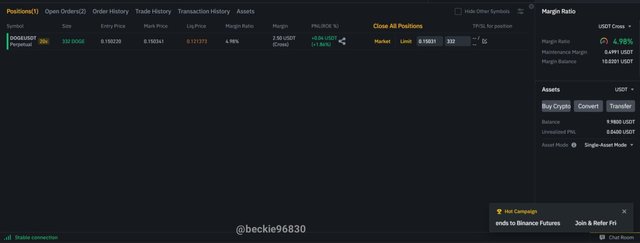

Question 8
What are the advantages and disadvantages of TEMA?
Advantages of TEMA
The TEMA indicator has notable advantages which include:
the TEMA indicator related to price changes faster than other types of moving averages, this is as a result of the lag reduction based on its calculation. This ensures capitalizing on trade opportunities early.
The TEMA represents price changes very similar to other moving averages, where trends are identified with the angle of the indicator line upward or downward, making it relatively easy to use and understand.
The TEMA also identifies dynamic support and resistance levels following the further development of price movement. This helps traders identify entry and exit points when trading.
The TEMA indicates buying and selling opportunities with its crossover strategy, where two TEMA with different period is combined to generate a trade signal.
Disadvantages of TEMA Indicator
The TEMA indicator has notable disadvantages which include :
The TEMA indicator is only useful in trending market conditions. In the absence of a trending market structure, the TEMA often generates distorted trade signals.
The reduced lag of the TEMA indicator in some cases generates an unclear signal as the indicator reacts fast to price movement, making it less reliable in volatile market conditions.
The TEMA indicator dynamic resistance and support level can easily be swapped because of how gats it reacts to price. For instance, taking a sell position after a break below the TEMA line serves as dynamic resistance, then the next candle closes back above the TEMA line.

Conclusion
TEMA works by applying a smoothing function generated from its calculation. This function ensures that lags and random price fluctuation are ignored by the indicator, resulting in a smoothened representation of the indicator data in relation to price movement. The TEMA indicator represents trends directions using the angled slope of its oscillating line. TEMA also identifies dynamic support and resistance levels following the further development of price movement. This helps traders identify entry and exit points when trading.
Thank you professor @fredquantum for this educative and insightful lesson.